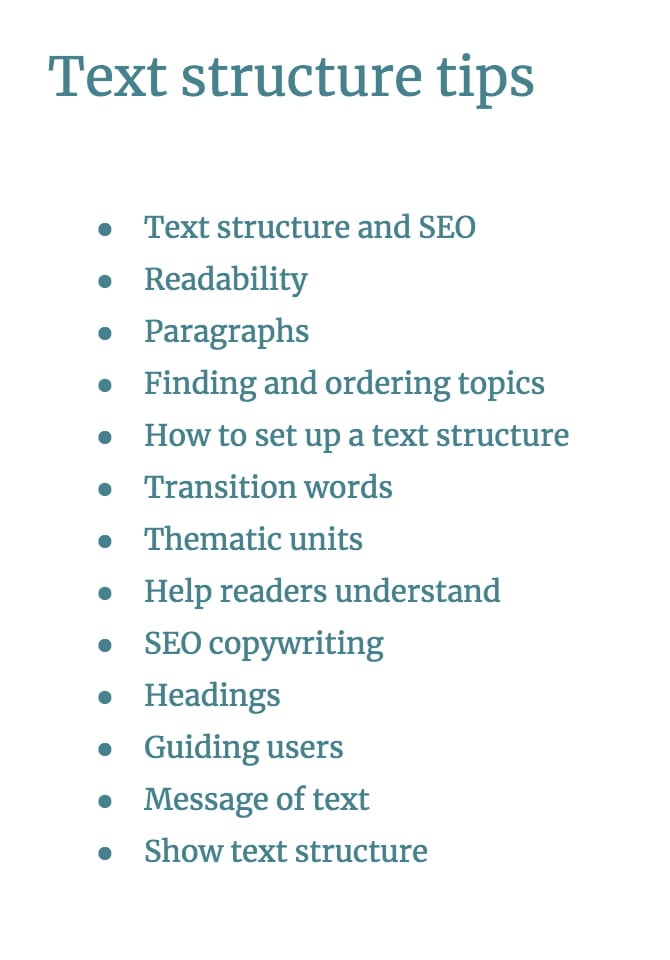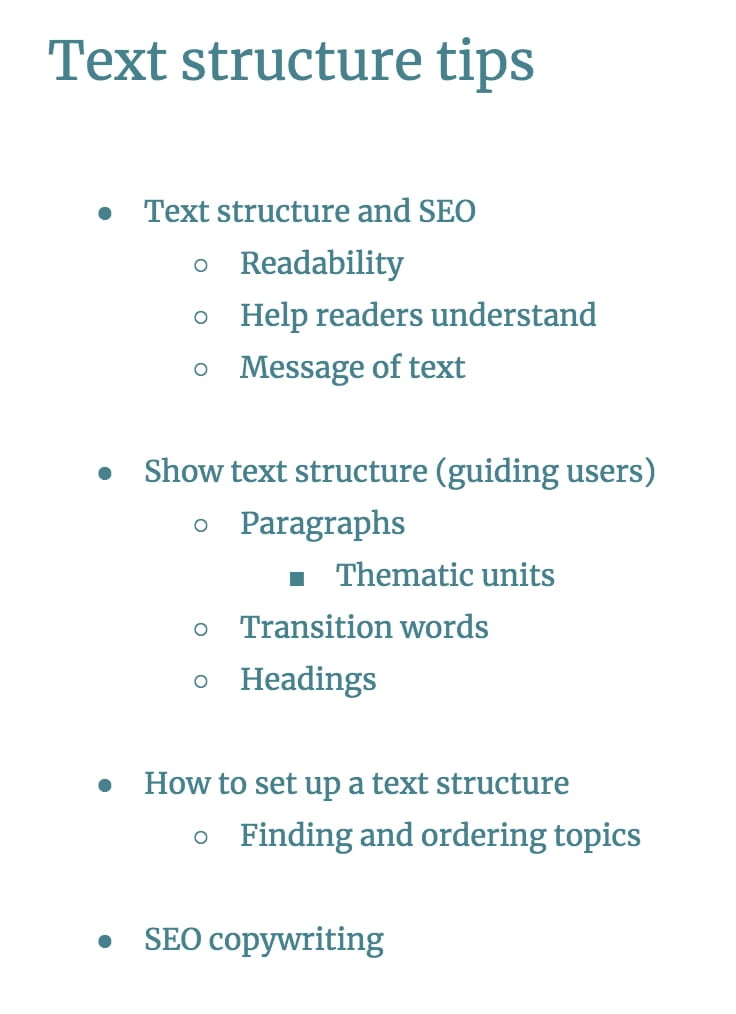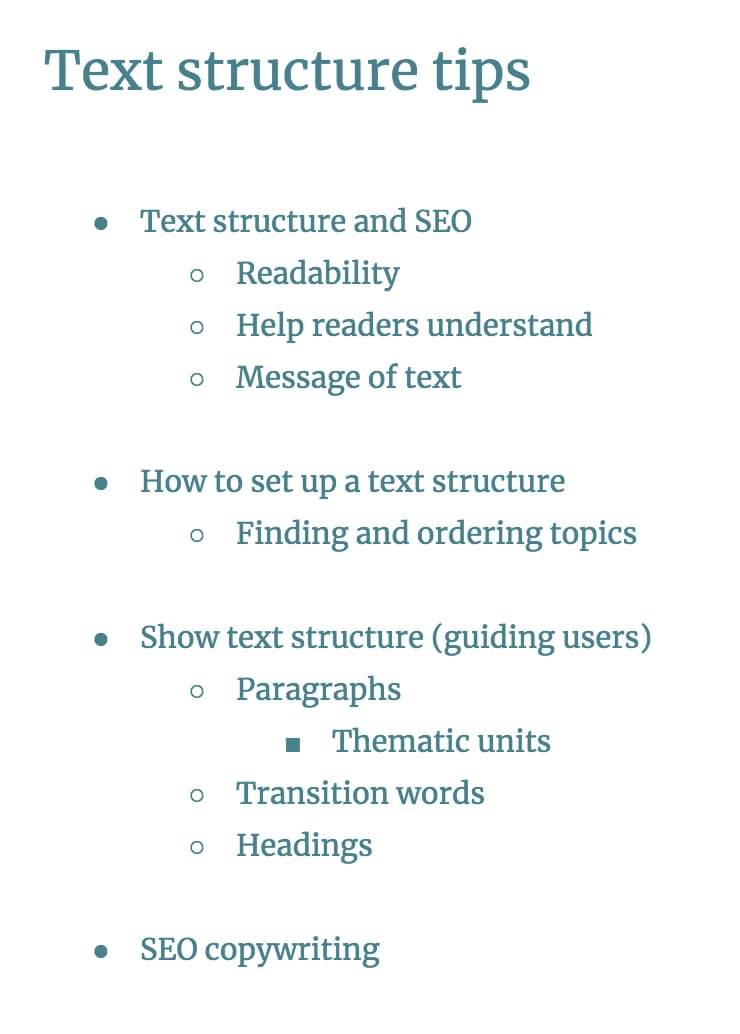How To Write A Blog Post Article
When blogging, it pays dividends to lay out the structure of your piece before you begin writing. The structure is the skeleton of your text and preparing it has multiple benefits. Firstly, it's easier to write a text when your structure is already there. Secondly, a clear structure helps the reader to easily read your post and grasp the core message. Here, we'll give you practical tips on how to structure your blog post.
Table of contents
- Why is text structure important for SEO?
- How to structure a blog post?
- Text order types
- Guide users through your text
- 1. Create paragraphs
- 2. Use transition words
- 3. Use headings to help your reader
- 4. Add a table of contents
- A better structure leads to better copy
Why is text structure important for SEO?
Structuring a text well improves readability and, thereby, helps your readers to understand your text. If readers better understand the information you provide, it's more likely they'll find the answer to the question they have. When Google notices, by so-called user signals, you're giving valuable answers to certain queries, chances are you'll climb the rankings.
Read more: why text structure is important for SEO »
Creating a clear text structure is just one aspect of SEO copywriting. If you want to master all facets, take a look at our SEO copywriting training, which is part of our online SEO training subscription.
How to structure a blog post?
Think before you start writing. Get a pen and paper and write down what you want to write about. That could include a bit of keyword research, but ideally, you've already done that. Check out our ultimate guide to keyword research for more on this. Next, set up a text structure and keep it close to hand while writing your blog post. One way of setting up a structure for your text is by following these three steps:
- Create a list of topics
Once you've gathered all the information you want to use in your post or article, you can begin structuring, so make a list of everything you want your article to cover. For instance, for this post this could be:

- Bundle topics together
When you have a clear overview of all the topics you want to discuss in your article, you can start bundling topics. Similar topics should, of course, be discussed together. For this post, this could look like this:

- Order your topics
When you're done bundling, you should decide on the order of the topics in your article. In most cases, you can decide to order thematically. For instance, if you want to discuss various aspects or angles of the main topic of your blog post. But you can also order your text chronologically or didactically, as you can see in the order types table below. In the example we're discussing, ordering topics thematically makes the most sense:

- Write a few words about every sub topic
After you've ordered the topics you want to address in your article, you should make a new list. This list essentially is a summary of the article you're about to write. Write a short sentence or a few words for every paragraph you plan to write. This list serves as the skeleton of your article, and you should keep it close to refer to during the rest of the writing process.
Text order types
Apart from arranging the order of topics according to a theme; you could also order them chronologically or by explaining the basics first and going on to more difficult aspects – known as a didactic order. This is a good idea when you are trying to explain a complicated subject:
| Order type | |
|---|---|
| Thematic | ordered on theme, aspect, topic |
| Chronological | old to new |
| Didactic | easy to hard |
| Problem – solution(s) | introduce the problem first and then possible solutions |
Another way to order your articles is the inverted pyramid style, a method that's been used by journalists for ages. It means you start out with the most crucial element in the beginning and later add details and more background information. Especially in news articles, this works well.
Guide users through your text
So, now you've got a skeleton/summary of the text you're about to write. When you start writing keep the following best practices in mind to make sure the reader will easily flow through your well-crafted blog post structure!
1. Create paragraphs
You have bundled topics together in the text structure you have set up, so now you can start to write your paragraphs. But what makes a good paragraph? A paragraph can be defined by three things. Remember these things while writing!
- A paragraph should form a thematic unit.
- A paragraph contains one core sentence and an elaboration of this core sentence.
- Info should be made more visible by using whitespace.
Lots of people make mistakes while creating paragraphs. Some writers just put whitespace in their text in random places for aesthetic purposes but don't think about the coherence and structure of the text. In many cases, the coherence within paragraphs and between paragraphs remains unclear. These kinds of mistakes can mess up the structure of your articles.
Paragraphs can be short or long. The length of a paragraph is decided by the theme you are discussing, so it could be anywhere between two and fifteen sentences. However, for writing on websites, we would advise creating short paragraphs (keep it to less than 6 or 7 sentences). Because reading from a screen is hard.
For text on websites, we'd advise you to start your paragraph with the most important sentence, then explain or elaborate on it. A reader will be able to grasp the most important concepts from your article, just by reading the first sentences of your paragraphs. You can conclude longer paragraphs with a summarizing sentence to clarify your point.
2. Use transition words
To guide your reader, you should use plenty of transition words. Transition words give direction to your readers. These words show the reader that you're summarizing (e.g. and, too), comparing (e.g. less than, rather) or concluding something (e.g. thus, consequently, hence).Table 2: examples of transition words
| Type of relation | Examples of transition words |
|---|---|
| enumerate | and, first of all, also, another, furthermore, finally, in addition |
| cause | because, so, due to, while, since, therefore |
| compare/contrast | same, less, rather, while, yet, opposite, much as, either |
| conclude | as a result, hence, consequently, therefore, in conclusion |
| ambiguity | seems like, maybe, probably, almost |
| emphasize | most of all, most noteworthy, especially relevant |
Using transition words is like putting cement between your sentences – they show your readers the connection between sentences and paragraphs.
If you're not used to using transition words, it can be hard to correct content you have already written. Be sure to use transition words whenever you are summarizing or enumerating. Also, using signal words in your conclusion helps people to grasp your core message.
3. Use headings to help your reader
In the first place, headings are of great importance for your readers. Headings allow your readers to quickly scan through your text and decide whether or not (or which parts of) they want to read your article. Therefore headings should be attractive and should cover the content of the paragraphs below. Whether headings play a direct role in SEO is debatable, but if readers easily grasp the message of your content, that surely helps your SEO.
You should put a heading above each paragraph, or above a series of paragraphs which contain similar topics. The headings should reflect the structure of your text. We advise you to put a heading above very long paragraphs, or above several shorter paragraphs which are thematically similar. Here's a detailed guide on how to implement headings in your post and on your site.
4. Add a table of contents
Landing on a page and not having a clue what to find there can make people hesitant to read on. Just seeing a long piece of text might even scare people away. Most people don't take the time to read your entire post, so to help them check whether this post offers them what they are looking for you can add a table of contents in the beginning. Especially, if you've written an extensive post or page, a table of contents give the readers a sense of control, and the possibility to scan which topics you deal with in post.
If you followed the steps above, your post will have a decent structure and headings already, which means this advice is easy to implement! The old-fashioned way to implement a table of contents is adding anchor tags to all your headings and adding a [TOC] shortcode at the beginning of your post. But if you're using the WordPress block editor together with Yoast SEO premium it's even easier! We've now added a TOC block to the Yoast SEO blocks. This means you'll just have to look for the right block, add it to your post, and you're done:
A better structure leads to better copy
Setting up a coherent structure for your blog post is an essential step of SEO copywriting. It will result in a better understanding of the message of your blog posts. If people understand your message, they will be much more likely to share your post on social media or buy what you are selling.
Taking time to think about a clear text structure before you start writing is worth your while. As you're writing, think about the structure of your paragraphs, your use of transition words and the headings in your post. If you follow these 'rules' your blog post will be far more understandable and readable to your audience.
Want to dive deeper into the subject of copywriting? Sign up for our SEO copywriting course for more writing tips!
Keep reading: The ultimate guide to Content SEO »
Marieke van de Rakt is creative marketing manager at Yoast. She loves writing about content SEO, speaking at WordCamps and improving Yoast SEO and the Yoast SEO Academy: the online courses platform.

Coming up next!
How To Write A Blog Post Article
Source: https://yoast.com/writing-blog-creating-clear-blog-post-structure/
Posted by: stampernernat.blogspot.com

0 Response to "How To Write A Blog Post Article"
Post a Comment